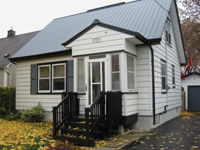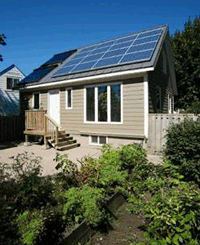|
Increasingly, builders are offering new, energy-efficient houses and condos. But not everyone can or wants to buy a new home in a newly developed area. For many people, improving their existing house is the best economic and lifestyle choice. The Now House™ project is addressing this issue, and, with the help of a team of designers, architects, engineers, homeowners and sustainable building experts, will turn a 60-year-old house in an established Toronto neighborhood into one that produces as much energy as it uses. In the process, the homeowner’s energy bill should be eliminated and greenhouse gas (GHG) emissions cut by six tonnes annually – a 60 percent decrease. Now House™ is one of 12 teams from across Canada chosen by Canada Mortgage and Housing Corporation for their EQuilibrium demonstration home competition.
The two-bedroom, 650-square-foot Now House™, located in an established Toronto neighborhood, is one of tens of thousands of “Victory Homes” – housing built for veterans after the Second World War. Clustered in orderly configurations on small lots, these partially prefabricated houses were meant to temporarily fill the gap in the post-war housing market. But they remain a fixture in many cities and many have been renovated, although usually without much thought given to modern energy-saving amenities.
This house, on the other hand, will be retrofitted with the latest healthy, energy efficient and sustainable features and technologies and the Now House™ will become a green showcase. Team Leader Lorraine Gauthier, co-founder of the innovative Toronto design studio Work Worth Doing, says the project will demonstrate how homeowners and their local contractors can improve energy efficiency of older housing with a few simple but innovative modifications.
These modifications include upgraded insulation; E-rated windows; light tubes and light shelves outside the windows to reflect light indoors, new Energy Star certified appliances, heat-recovery systems such as air exchangers and tubing that reclaims heat from water going down drains, phantom-load switches that cut power to appliances designed to be left on standby and solar photovoltaic power. All of these simple innovations will generate surplus electricity at peak load periods during the day and send it back to the grid for income generation using the Ontario Power Authority Standard Offer program, achieving a net-zero effect.
One of the aims of the project is to keep costs reasonable. To that end, the retrofit will focus on the reuse and conservation of existing elements in the home. For instance, the existing siding will be put back on after the insulation upgrade. The existing steel-clad roof will also remain, with solar panels being installed over top.
Since these wartime houses are ubiquitous, Gauthier says that her team plans to export the Now House™ model across the country. And because the Now House™ is modest in size and design, it will be easy for the average homeowner to relate to it and learn about modifications that will suit their home.
EQuilibrium or Net-Zero Housing
EQuilibrium housing is a national housing initiative, led by Canada Mortgage and Housing Corporation (CMHC), that brings the private and public sectors together to develop healthy, energy-efficient homes. The initiative is a renaming of the Net-Zero Energy Healthy Housing program, which was featured in Natural Life’s July/August 2006 issue. CMHC invited builders and developers to submit proposals to take part in a pilot project and 12 teams were chosen to build EQuilibrium demonstration homes. Each winning team receives $50,000 to offset eligible costs, including those relating to documenting the projects, performance testing and demonstrating the homes publicly.
An EQuilibrium healthy house is a highly energy efficient home that produces as much energy as it uses on an annual basis and is designed to become the basis for a sustainable community. Elements include: climate specific design; energy and resource efficient construction; passive solar heating and cooling; natural daylighting; energy-efficient appliances and lighting; renewable energy systems, such as photovoltaics, solar thermal and ground-source heat systems; water conservation and re-use; land and natural habitat conservation; sustainable community design and green infrastructure practices; utility grid connection to exchange energy.
Where: Toronto, Canada
What: 650-square-foot, two-bedroom house built in 1946
Who: Collaborative effort between Work Worth Doing design studio, David Fujiwara Architect, Alpha Tec Consulting and Construction and the combined expertise of more than 60 volunteer housing professionals, consultants and community members
Contact: www.nowhouseproject.com
|

Urban home before retrofit

The Now House™ solar photovoltaic system features two panels permanently mounted on the south-facing roof at an adjusted slope of 30 degrees. The panels each measure 92 square feet, for a total area of 184 square feet (17.1 square meters.) The nominal PV array power is 2.0 kWp. DC to AC. Inverter efficiency is 90 percent and the system will deliver 2.433 MWh annually.
The roof-mounted solar thermal hot water heat system supplies a domestic hot water pre-heat system, radiant floor heat system and a ducted space heating system. There are two 32-square-foot glazed flat plate solar collectors producing 1604 KWh (11.5 GJ) total output. The system is a closed loop with glycol, pump, valves, expansion tank, controls and heat exchanger. The existing gas-fired hot water tank is re-used as a pre-heat storage tank. The system is augmented with a high efficiency tankless gas water heater.
Photo courtesy CMHC
|

